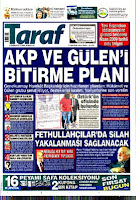Etyen Mahçupyan
In an atmosphere in which assertions that the ruling party has become more authoritarian are being trumpeted by some, the start of the 1980 coup trial has been purposely scheduled for the same time as the final stages of the Balyoz [Sledgehammer] case. This is not just a symbolic connection. After all, the Balyoz plan, which was created in seminars by the 1st Army under the direction of Çetin Doğan, came together through the refreshing of the Bayrak [Flag] plan [the plan behind the 1980 coup].
This time around though, the imperfections and deficiencies of the plan were detected, and a much more detailed plan of action was produced. In accordance with this, the new plan listed the names of targets and people shouldering duties within the coup, how the various military units were to be used during the actual coup and -- most notably -- which individuals were to lead which institutions in the wake of the coup and which individuals were to compose the cabinet of government ministers.
From the very start of the trial process, the defense has maintained that some of the documents that had been presented to the court were forged. This is because an analysis of the documents found in the military’s possession has led to the firm conclusion that if, in fact, these documents are real, there was really a coup plan at hand… So really, the only route of defense left was to convince the court that the documents were, in fact, forged. However, a technical analysis of the documents did not support the allegations that they were forged. According to the defense, the fact that some of the documents on these CDs have the names of institutions in them that were formed after 2003 hints at the possible illegitimacy of these documents. But in response to this, it needs to be pointed out that these documents were constantly returned to and adapted according to new situations. Another objection from the defense is that the CDs asserted to be forgeries contain some fonts that did not even exist in Microsoft software in 2003. But the truth is, the technical analysis provided by Microsoft reveals that, in fact, a file opened using a 2007 operating system can, in fact, change the fonts on files created much earlier and can make a file appear as if it had been saved for the first time. What’s more, the fonts that the defense has said did not even exist in 2003 have been found on CDs that the defense accepts as “authentic.” Because they constantly updated the coup plan, it was used until 2008.
The trial has focused heavily on the CDs asserted to be forgeries, but in the end, the defense has been unable to prove that they were, in fact, forged. In the meantime, CDs accepted by the defense as legitimate and recognized by quite a few witnesses as legitimate contained on their own more than enough in the way of detailed coup information. The coup instigators knew they would not be able to overcome this particular wealth of details, which is why they crafted their defense this way and followed a more politically based than justice-based strategy. Their aim was to make the EU and Turkish publics believe that such trickery had been done to the CDs. Propaganda spreading the word that the Justice and Development Party (AK Party) had become more authoritarian, that the ruling party was trying to intimidate the opposition and that the Gülen movement was trying to set up traps for the military and nationalists was created. At the same time, the rise of uneasiness toward Turkey in Europe began to be reflected in EU circles.
At the same time, though, what we really have here is a very simple case that really does not possess many question marks; a multitude of evidence was discovered in the hands of different authorities and offices. In other words, these were all prepared in an atmosphere of secrecy that would not have allowed for anyone from the outside to intervene. In accordance with the mentality necessary for a coup, the plan was constantly returned to, and admissions made in court to this extent confirmed this. What’s more, the 1st Army Commander’s Office changed the points of discussion for the seminar, despite the clear orders of the Land Forces Commander’s Office; the plan that was supposed to be debated in the seminar was replaced by the Balyoz plan, which was based on the idea of a national threat. This change was hidden. In other words, what we have here is not just a coup plan, but preparation that shows this plan was definitely going to be used for a real coup.
It is the first time in Turkey that an attempted coup is being tried based on this many details and concrete pieces of evidence. The defense asserts that since the suspects in the Sept. 12, 1980 coup were actually successful, they cannot be seen as guilty, and since the Balyoz suspects did not actually carry out a coup, they are also not guilty… As for Turkish society, it is familiar with these events through its own experiences from the “inside.” It is clearly evident that Balyoz was, in fact, an attempted coup, and that it was a product of what happened on Sept. 12, 1980. What is different this time around is that for the first time, civilian society has demanded a trial and is calling a spade a spade at last.
Published on Today's Zaman, 12 April 2012, Thursday
Related Articles:
Latest news, academic excerpts, commentary, book reviews and interviews on Fethullah Gulen and the Hizmet Movement (aka The Gulen Movement).
Search This Blog
Overview
Content from 164 countries/states
Categories
New Audio Podcast
Some Highlights
- Top Three Reasons Why Turkey’s President Erdogan is Obsessed with Gulen
- Turkish witch-hunt against the Gulen movement lacks one thing: Evidence
- Bill Clinton on Fethullah Gulen's contribution to the world
- Erdoğan’s war against Hizmet: Step by step
- Is Gulen Movement a religious order?
- Is the Gülen Movement a civil society initiative?
- Popular Islam – Hizmet-Gülen Movement and Fethullah Gülen
- Why do they lie about Fethullah Gülen?
- The Responsibility of the Hizmet movement
- Gülen movement is a chance for humanity, American professor says
- Gulen Movement: An attempt to represent Islam and Muslims positively
- Muslims Must Combat the Extremist Cancer
- The Place of the Gulen Movement in the intellectual history of Islam
- A Universal Islamic Phenomenon in Turkish Religious Practice: the Gülen Case
Suggested Readings
Disclaimer: Copyrights and ideas in the articles belong to their respective owners. Hizmet Movement (Gulen Movement) Blog may not be held liable from the content of articles nor their potential misuse by third parties. Articles shared are not necessarily endorsed. Links and images used in the blog posts may differ from those at their original source. Translated articles are solely intended for the convenience of the readers, and may include minor errors.



